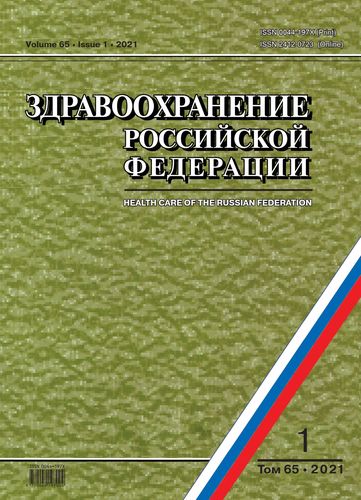Laboratory information systems in internal quality control of a cardiac surgery hospital
- Autores: Bockeria L.A.1, Satyukova A.S.1, Yarustovskiy M.B.1, Tetvadze I.V.1, Kupryashov A.A.1, Shcherbak A.V.1, Kirtbaya L.N.1, Smirnov I.S.1, Grankov A.V.1
-
Afiliações:
- A.N. Bakulev National Medical Research Center of Cardiovascular Surgery
- Edição: Volume 65, Nº 1 (2021)
- Páginas: 12-16
- Seção: HEALTH CARE ORGANIZATION
- ##submission.dateSubmitted##: 25.10.2024
- URL: https://hum-ecol.ru/0044-197X/article/view/637926
- DOI: https://doi.org/10.47470/0044-197X-2021-65-1-12-16
- ID: 637926
Citar
Texto integral
Resumo
Introduction. In recent years, laboratory information systems (LIS) have become an element of medical institutions’ work, providing high quality and efficiency of clinical activities. Laboratory diagnosis plays a vital role in treating and preventing all known diseases, which requires compliance with specific quality criteria.
Material and methods. A study was conducted with the historical control of the laboratory tests’ conditiona-lity before and after introducing LIS in the A.N. Bakulev National Medical Research Center of Cardiovascular Surgery. During 2018, quarterly an analysis of the reappointments of the following groups of laboratory tests was carried out: hematological test, immunochemical analysis, biochemical blood test, hemostasis system (coagulogram), platelet aggregation with ADP. Unfounded recognized studies assigned more than once for 48 hours in the absence of clinical justification. Results are provided using standard descriptive statistics methods.
Results. After the work carried out in the fourth quarter, there was a decrease in the total number of appointments by 20% and a decrease in studies performed in terms of one patient.
Conclusion. The introduction of LIS made it possible to obtain a tool for quantitative and qualitative analysis of the validity of the purpose of laboratory research and conduct an economic analysis of the results. The data obtained were subsequently used to develop laboratory profiles, allowing to continue the optimization of this area and the implementation of lean technologies in the clinic. Also, the data obtained made it possible to evaluate the knowledge and application of clinical recommendations to manage patients with various pathologies. During the verification of the results and analysis of the doctors’ explanatory notes, the laboratory process’s most compromised stages were identified.
Sobre autores
Leo Bockeria
A.N. Bakulev National Medical Research Center of Cardiovascular Surgery
Autor responsável pela correspondência
Email: noemail@neicon.ru
ORCID ID: 0000-0002-6180-2619
Rússia
Anna Satyukova
A.N. Bakulev National Medical Research Center of Cardiovascular Surgery
Email: noemail@neicon.ru
ORCID ID: 0000-0001-5948-1193
Rússia
Mihail Yarustovskiy
A.N. Bakulev National Medical Research Center of Cardiovascular Surgery
Email: noemail@neicon.ru
Rússia
Inga Tetvadze
A.N. Bakulev National Medical Research Center of Cardiovascular Surgery
Email: noemail@neicon.ru
ORCID ID: 0000-0001-8730-2201
Rússia
Aleksei Kupryashov
A.N. Bakulev National Medical Research Center of Cardiovascular Surgery
Email: noemail@neicon.ru
ORCID ID: 0000-0001-7673-4762
Rússia
Anastasia Shcherbak
A.N. Bakulev National Medical Research Center of Cardiovascular Surgery
Email: avscherbak@bakulev.ru
ORCID ID: 0000-0002-0723-9028
Cardiovascular surgeon, laboratory for quality treatment control, A.N. Bakulev National Medical Research Center of Cardiovascular Surgery, Moscow, 121552, Russian Federation.
e-mail: avscherbak@bakulev.ru; a.shcherbak.work@gmail.com
RússiaLana Kirtbaya
A.N. Bakulev National Medical Research Center of Cardiovascular Surgery
Email: noemail@neicon.ru
ORCID ID: 0000-0003-3611-2015
Rússia
Ivan Smirnov
A.N. Bakulev National Medical Research Center of Cardiovascular Surgery
Email: noemail@neicon.ru
Rússia
Andrey Grankov
A.N. Bakulev National Medical Research Center of Cardiovascular Surgery
Email: noemail@neicon.ru
ORCID ID: 0000-0003-1391-5624
Rússia
Bibliografia
- Sepulveda J.L., Young D.S. The ideal laboratory information system. Arch. Pathol. Lab. Med. 2013; 137(8): 1129-40. https://doi.org/10.5858/arpa.2012-0362-ra
- Palla P., Frau G., Vargiu L., Rodriguez-Tomé P. QTREDS: a Ruby on Rails-based platform for omics laboratories. BMC Bioinf. 2014; 15 (Suppl. 1): S13. https://doi.org/10.1186/1471-2105-15-s1-s13
- Dangott B. Specialized laboratory information systems. Surg. Pathol. Clin. 2015; 8(2): 145-52. https://doi.org/10.1016/j.path.2015.02.003
- Cucoranu I.C. Laboratory information systems management and operations. Surg. Pathol. Clin. 2015; 8(2): 153-7. https://doi.org/10.1016/j.path.2015.02.002
- Henricks W.H. Laboratory information systems. Surg. Pathol. Clin. 2015; 8(2): 101-8. https://doi.org/10.1016/j.path.2015.02.016
- Kammergruber R., Robold S., Karliç J., Durner J. The future of the laboratory information system - what are the requirements for a powerful system for a laboratory data management? Clin. Chem. Lab. Med. 2014; 52(11): e225-30. https://doi.org/10.1515/cclm-2014-0276
- Sinard J.H., Castellani W.J., Wilkerson M.L., Henricks W.H. Stand-alone laboratory information systems versus laboratory modules incorporated in the electronic health record. Arch. Pathol. Lab. Med. 2015; 139(3): 311-8. https://doi.org/10.5858/arpa.2013-0711-so
- Farzandipour M., Meidani Z., Sadeqi Jabali M., Dehghan Bnadaki R. Designing and evaluating functional laboratory information system requirements integrated to hospital information systems. J. Eval. Clin. Pract. 2019; 25(5): 788-99. https://doi.org/10.1111/jep.13074
- Lukić V. Laboratory information system - where are we today? J. Med. Biochem. 2017; 36(3): 220-4. https://doi.org/10.1515/jomb-2017-0021
- Lemmon V.P., Jia Y., Shi Y., Holbrook S.D., Bixby J.L., Buchser W. Challenges in small screening laboratories: implementing an on-demand laboratory information management system. Comb. Chem. High Throughput Screen. 2011; 14(9): 742-8. https://doi.org/10.2174/138620711796957161
- Plebani M., Carrano P. Mistakes in a stat laboratory: types and frequency. Clin. Chem. 1997; 43(8 Pt. 1): 1348-51.
- Plebani M., Carrano P. Errors in a stat laboratory: types and frequencies 10 years later. Clin. Chem. 2007; 53(7): 1338-42. https://doi.org/10.1373/clinchem.2007.088344
- Harel A., Dalah I., Pietrokovski S., Safran M., Lancet D. Omics data management and annotation. Methods Mol. Biol. 2011; 719: 71-96. https://doi.org/10.1007/978-1-61779-027-0_3
- Mohammadzadeh N., Safdari R. The intelligent clinical laboratory as a tool to increase cancer care management productivity. Asian Pac. J. Cancer Prev. 2014; 15(6): 2935-7. https://doi.org/10.7314/apjcp.2014.15.6.2935
- Mirzazadeh M., Morovat A., James T., Smith I., Kirby J., Shine B. Point-of-care testing of electrolytes and calcium using blood gas analysers: it is time we trusted the results. Emerg. Med. J. 2016; 33(3): 181-6. https://doi.org/10.1136/emermed-2015-204669
Arquivos suplementares









